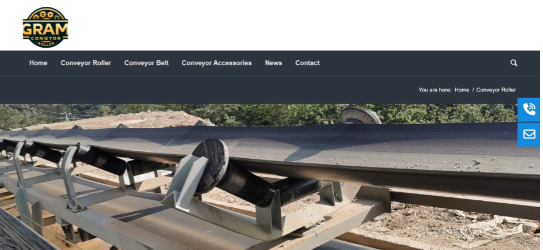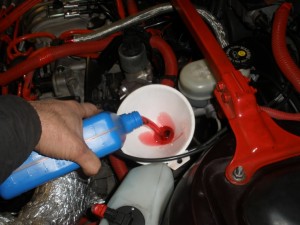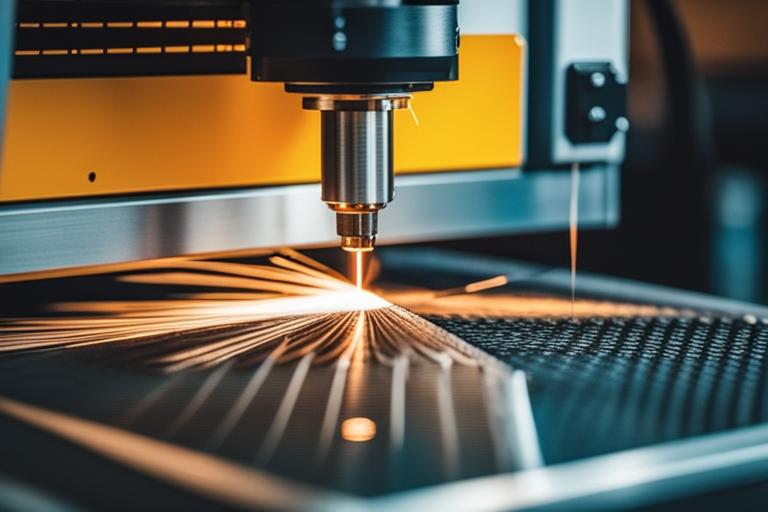Tech
Choosing the Right Conveyor Roller for Your Needs

Selecting the right conveyor roller is crucial for ensuring the efficiency and longevity of a conveyor system. The appropriate roller type can significantly impact the smooth transportation of materials, reduce maintenance costs, and enhance overall productivity. Conveyor rollers come in various types, each designed to meet specific industrial needs. These include steel rollers for heavy-duty applications, rubber-coated rollers for improved grip and noise reduction, and nylon rollers known for their durability and corrosion resistance. Understanding the unique features and benefits of each type helps in making informed decisions, tailored to the demands of different operational environments.
Conveyor Roller Types
Conveyor rollers are an essential component in many types of conveyor systems, facilitating the movement of products and materials along the conveyor path. The design, material, and application of the rollers can significantly impact the efficiency and effectiveness of the conveyor system. Below, we delve into the various types of conveyor rollers, highlighting their specific characteristics, uses, and benefits.
Gravity Rollers
Gravity rollers are the simplest form of conveyor rollers. They do not require any external power to function, relying solely on gravity to move items along the conveyor path. These rollers are commonly used in warehouses and distribution centers where the transportation of goods can be done manually or by the natural slope of the conveyor system.
Key Characteristics:
Material: Typically made from steel or aluminum.
Cost-effective: Low initial and maintenance costs.
Durability: Suitable for handling medium to heavy loads.
Applications:
– Packaging lines
– Assembly lines
– Order picking and fulfillment areas
Powered Rollers
Powered rollers, also known as live rollers, are driven by motors and can transport products automatically. These rollers are ideal for applications requiring precise control over the movement of items.
Key Characteristics:
Material: Usually made from steel, but can also be coated with rubber or plastic for specific applications.
Variable Speed: Can be adjusted to control the speed of the conveyor.
Efficiency: High throughput capabilities.
Applications:
– Manufacturing lines
– Distribution centers
– Automated sorting systems
Plastic Rollers
Plastic rollers are lightweight and corrosion-resistant, making them suitable for specific environments where traditional metal rollers might not perform well.
Key Characteristics:
Material: High-quality plastic such as polypropylene or nylon.
Lightweight: Easier to handle and install.
Corrosion-resistant: Ideal for use in wet or corrosive environments.
Applications:
– Food processing
– Chemical manufacturing
– Cleanrooms
Stainless Steel Rollers
Stainless steel rollers are known for their durability and resistance to corrosion, making them ideal for heavy-duty applications and harsh environments.
Key Characteristics:
Material: High-grade stainless steel.
Durable: Can withstand heavy loads and harsh conditions.
Hygienic: Easy to clean and maintain.
Applications:
– Pharmaceutical manufacturing
– Food and beverage industry
– Outdoor conveyor systems
Rubber-Coated Rollers
Rubber-coated rollers provide additional grip and cushioning, making them suitable for handling delicate or fragile items.
Key Characteristics:
Material: Steel core with a rubber or urethane coating.
Shock Absorption: Reduces damage to products during transportation.
Traction: Improved grip on items.
Applications:
– Glass and ceramics transport
– Electronics manufacturing
– Textile industry
Conical Rollers
Conical rollers are used in curved sections of conveyor systems, allowing for smooth and consistent movement around bends.
Key Characteristics:
Material: Can be made from steel, aluminum, or plastic.
Tapered Design: Facilitates smooth navigation around curves.
Customizable: Available in various sizes and taper angles.
Applications:
– Airport baggage handling
– Parcel sorting facilities
– Manufacturing plants with curved conveyor lines
Polyurethane Rollers
Polyurethane rollers are designed for applications requiring a combination of durability, chemical resistance, and noise reduction.
Key Characteristics:
Material: Polyurethane-coated steel or aluminum core.
Chemical Resistance: Suitable for use in environments with exposure to oils, solvents, and other chemicals.
Quiet Operation: Reduces noise during conveyor operation.
Applications:
– Automotive industry
– Heavy equipment manufacturing
– Aerospace industry
Conveyor Impact Rollers
Conveyor impact rollers are reinforced to absorb shock and prevent damage to both the conveyor system and the materials being transported.
Key Characteristics:
Material: Steel or rubber-coated steel.
Shock Absorption: Designed to handle high-impact areas.
Durability: Long-lasting even under extreme conditions.
Applications:
– Mining operations
– Bulk material handling
– Quarry conveyor systems
Choosing the right type of conveyor roller is crucial for optimizing the efficiency and longevity of a conveyor system. Each type of roller offers unique benefits tailored to specific applications and environments. By understanding the characteristics and applications of each roller type, businesses can select the best solutions to meet their operational needs.
Best Nylon Conveyor Rollers
Nylon conveyor rollers are a popular choice in many industries due to their unique blend of strength, durability, and lightweight properties. They are particularly valued for their resistance to wear and corrosion, making them suitable for a wide range of applications. In this section, we will explore the characteristics of high-quality nylon rollers and provide recommendations on some of the best products and brands in the market.
Characteristics of High-Quality Nylon Rollers
Understanding the key characteristics of high-quality nylon rollers can help in selecting the best products for your needs. Below are some essential features to consider:
Material Composition
High-quality nylon rollers are made from premium nylon materials that offer excellent mechanical properties. The best rollers often use high-density nylon, which provides superior strength and durability.
High-Density Nylon: Offers better load-bearing capacity and wear resistance.
Additives: Some nylon rollers are enhanced with additives to improve specific properties, such as UV resistance or anti-static capabilities.
Durability and Wear Resistance
Nylon rollers are known for their long lifespan and ability to withstand harsh environments. They exhibit excellent wear resistance, which is crucial for maintaining performance over time.
Wear Resistance: Ensures longevity and reduces maintenance costs.
Impact Resistance: Can handle shocks and impacts without cracking or deforming.
Lightweight
One of the main advantages of nylon rollers is their lightweight nature. This makes them easier to install and reduces the overall weight of the conveyor system, which can be beneficial for certain applications.
Ease of Installation: Simplifies the assembly process.
Energy Efficiency: Reduces the energy required to drive the conveyor system.
Corrosion Resistance
Nylon rollers are highly resistant to corrosion, making them ideal for use in environments where they might be exposed to chemicals, moisture, or other corrosive substances.
Chemical Resistance: Suitable for chemical manufacturing and food processing.
Moisture Resistance: Prevents degradation in humid or wet conditions.
Low Noise Operation
Nylon rollers operate quietly, which is an essential feature in environments where noise reduction is critical, such as in office buildings or hospitals.
Noise Reduction: Minimizes operational noise, contributing to a quieter working environment.
Recommended Products and Brands
Several brands and products stand out in the market for their superior quality and performance. Below are some of the best nylon conveyor rollers available:
GRAM Conveyor
The GRAM Conveyor is renowned for its high-quality nylon material and exceptional performance. These rollers are designed for heavy-duty applications and offer a combination of durability, lightweight, and easy maintenance.
Key Features:
– High-grade nylon material for excellent strength and wear resistance.
– Lightweight design for easy installation and energy efficiency.
– Corrosion-resistant properties suitable for various industrial environments.
Applications:
– Mining operations
– Manufacturing plants
Interroll – Polyamide Rollers
Interroll is a well-known name in the conveyor industry, and their polyamide rollers are among the best in the market. These rollers are made from high-quality polyamide, a type of nylon known for its robust performance and versatility.
Key Features:
– High load-bearing capacity.
– Excellent wear and impact resistance.
– Low friction and noise levels.
Applications:
– Material handling
– Distribution centers
– Packaging lines
Dyno – Nylon Rollers
Dyno offers a range of nylon rollers designed for various industrial applications. Their rollers are appreciated for their durability and efficiency, making them a reliable choice for demanding environments.
Key Features:
– Made from high-density nylon for enhanced durability.
– Corrosion-resistant and suitable for wet environments.
– Lightweight and easy to install.
Applications:
– Mining operations
– Manufacturing plants
– Warehouses
Conveyor Units – Nylon Conveyor Rollers
Conveyor Units provides high-quality nylon conveyor rollers known for their resilience and long service life. These rollers are designed to handle a wide range of materials and operating conditions.
Key Features:
– Premium nylon construction for superior strength and wear resistance.
– Smooth and quiet operation.
– Resistant to chemical and environmental corrosion.
Applications:
– Airport baggage handling
– Automotive industry
– Pharmaceutical manufacturing
Selecting the best nylon conveyor rollers involves considering factors such as material composition, durability, weight, corrosion resistance, and noise levels. The recommended products and brands listed above are known for their high quality and performance, making them suitable for various industrial applications. By choosing the right nylon rollers, businesses can ensure efficient and reliable operation of their conveyor systems, leading to improved productivity and reduced maintenance costs.
Conveyor Roller with Bracket
Conveyor rollers with brackets are essential components in many conveyor systems. They provide the necessary support and stability for the rollers, ensuring efficient and smooth operation. In this section, we will discuss the importance and functionality of conveyor rollers with brackets, as well as explore the various types of brackets and their applications.
Importance and Functionality
1. Support and Stability
Brackets play a crucial role in supporting conveyor rollers, maintaining their alignment, and ensuring they remain securely in place. This support is vital for the smooth and efficient movement of goods along the conveyor system.
Proper Alignment: Brackets ensure that rollers are correctly aligned, preventing deviations that could disrupt the flow of materials.
Secure Attachment: They provide a stable and secure attachment point for rollers, minimizing the risk of dislodgement or misalignment.
2. Load Distribution
Brackets help distribute the load evenly across the conveyor rollers, reducing the stress on individual rollers and enhancing the overall durability of the system.
Even Load Bearing: Ensures that the load is evenly distributed, preventing excessive wear on any single roller.
Enhanced Durability: By reducing localized stress, brackets contribute to the longevity of the conveyor system.
3. Ease of Maintenance
Conveyor rollers with brackets are designed for easy installation and maintenance. This feature helps minimize downtime and ensures the conveyor system remains operational.
Quick Replacement: Brackets allow for the quick and easy replacement of rollers, reducing maintenance time.
Modular Design: Many brackets are part of modular systems, making it easier to maintain and upgrade conveyor components.
Types of Brackets and Their Applications
There are various types of brackets used in conveyor systems, each designed for specific applications and operational requirements. Below, we explore some common types of brackets and their typical uses.
1. Fixed Brackets
Fixed brackets are the most basic type of conveyor roller bracket. They hold the roller in a fixed position and are suitable for applications where the conveyor path is straight and does not require frequent adjustments.
Applications:
– Simple straight conveyor lines
– Warehousing and distribution centers
– Manufacturing assembly lines
2. Adjustable Brackets
Adjustable brackets allow for the positioning of conveyor rollers to be modified. This flexibility is beneficial in applications where the conveyor path may need to change or where different roller positions are required to accommodate various load sizes.
Applications:
– Customizable conveyor systems
– Flexible manufacturing processes
– Assembly lines with varying product sizes
3. Swivel Brackets
Swivel brackets enable the rollers to pivot or rotate, allowing for greater flexibility in handling materials. These brackets are ideal for applications that involve curved conveyor paths or where items need to be redirected smoothly.
Applications:
– Curved conveyor sections
– Sorting and redirecting systems
– Parcel handling and distribution
4. Hinged Brackets
Hinged brackets are designed to allow the rollers to be easily lifted or moved aside. This feature is particularly useful for cleaning, maintenance, and quick access to the conveyor belt.
Applications:
– Food processing and packaging
– Pharmaceutical manufacturing
– Conveyor systems requiring frequent cleaning and maintenance
5. Spring-loaded Brackets
Spring-loaded brackets provide a cushioning effect, allowing the roller to absorb shocks and impacts. This type of bracket is useful in applications where the conveyor system handles heavy or irregular loads.
Applications:
– Mining and quarrying
– Heavy-duty material handling
– Impact zones in conveyor systems
6. Custom Brackets
Custom brackets are designed to meet specific requirements of unique conveyor applications. These brackets can be tailored to fit unusual conveyor layouts, specialized roller types, or specific environmental conditions.
Applications:
– Specialized industrial processes
– Custom-built conveyor systems
– Environments with unique operational challenges
Conveyor rollers with brackets are essential for the efficient and reliable operation of conveyor systems. They provide critical support, stability, and load distribution, ensuring that rollers function optimally. The variety of bracket types available allows for customization to meet specific application needs, enhancing the versatility and adaptability of conveyor systems. By understanding the importance and functionality of different brackets, businesses can select the best solutions to improve their conveyor operations, leading to increased efficiency, reduced downtime, and lower maintenance costs.
Carrying Roller Conveyor Belt
A carrying roller conveyor belt is a fundamental component in the smooth operation of conveyor systems. These belts, supported by carrying rollers, are essential for transporting materials efficiently from one point to another. In this section, we will explore the role of carrying roller conveyor belts in conveyor systems, key features that make them effective, and maintenance tips to ensure their longevity and reliability.
Role in Conveyor Systems
1. Material Transportation
The primary role of carrying roller conveyor belts is to transport materials efficiently across different stages of processing or handling. These belts are widely used in various industries to move bulk materials, packages, or products from one location to another.
Continuous Movement: Ensures a steady flow of materials, reducing manual handling and increasing operational efficiency.
Versatility: Suitable for transporting a wide range of materials, including raw materials, finished products, and packaging.
2. Support and Stability
Carrying rollers provide crucial support to the conveyor belt, ensuring it remains stable and aligned during operation. This stability is vital for maintaining the integrity of the transported materials and the conveyor system itself.
Belt Alignment: Prevents the belt from sagging or misaligning, which can cause operational disruptions.
Load Distribution: Evenly distributes the weight of the transported materials, minimizing wear and tear on the belt.
3. Enhanced Efficiency
By providing a smooth and consistent surface for material movement, carrying roller conveyor belts enhance the overall efficiency of the conveyor system. They reduce friction and resistance, allowing for faster and more reliable transportation.
Reduced Energy Consumption: Lower friction means less energy is required to move the belt, leading to cost savings.
Increased Throughput: Facilitates faster movement of materials, boosting productivity.
Key Features
1. Durable Material
Carrying roller conveyor belts are made from durable materials that can withstand the rigors of industrial environments. The choice of material affects the belt’s performance, longevity, and suitability for specific applications.
Rubber: Commonly used for its flexibility, strength, and resistance to abrasion.
PVC: Offers good chemical resistance and is suitable for food-grade applications.
Polyurethane: Known for its excellent wear resistance and load-bearing capacity.
2. Robust Design
The design of carrying roller conveyor belts is tailored to handle the specific demands of the materials they transport. This includes considerations for load capacity, speed, and environmental conditions.
Reinforced Construction: Ensures the belt can handle heavy loads without stretching or deforming.
Impact Resistance: Designed to absorb shocks and impacts, protecting both the belt and the materials.
3. Customizability
Carrying roller conveyor belts can be customized to meet the specific needs of different industries and applications. Custom features might include specific belt widths, lengths, and surface textures.
Belt Width and Length: Customized to fit the dimensions of the conveyor system and the size of the transported materials.
Surface Texture: Can be smooth or textured to accommodate different types of materials and improve grip.
Maintenance Tips
1. Regular Inspection
Frequent inspection of the conveyor belt and carrying rollers is essential to identify any signs of wear, damage, or misalignment. Early detection of issues can prevent major breakdowns and extend the belt’s lifespan.
Visual Checks: Look for signs of wear, such as fraying edges or surface cracks.
Roller Alignment: Ensure carrying rollers are properly aligned and rotating smoothly.
2. Proper Lubrication
Lubricating the moving parts of the conveyor system, including the carrying rollers, reduces friction and wear. Use the appropriate lubricant recommended by the manufacturer to maintain optimal performance.
Scheduled Lubrication: Follow a regular lubrication schedule to ensure all moving parts operate smoothly.
Avoid Over-Lubrication: Excess lubricant can attract dust and debris, causing additional wear.
3. Belt Tensioning
Maintaining the correct tension in the conveyor belt is crucial for its efficient operation. An improperly tensioned belt can slip, cause misalignment, or suffer excessive wear.
Tension Adjustments: Regularly check and adjust the belt tension as needed to maintain optimal performance.
Avoid Over-Tensioning: Excessive tension can strain the belt and rollers, leading to premature failure.
4. Cleaning and Debris Removal
Keeping the conveyor belt and rollers clean is vital for preventing material buildup that can cause operational issues. Regular cleaning helps maintain the efficiency and longevity of the conveyor system.
Routine Cleaning: Clean the belt and rollers regularly to remove dirt, dust, and debris.
Preventative Measures: Implement measures to minimize debris accumulation, such as installing scrapers or guards.
Carrying roller conveyor belts are integral to the effective functioning of conveyor systems, providing essential support, stability, and efficiency in material transportation. By understanding their role, key features, and maintenance requirements, businesses can ensure these belts operate reliably and efficiently. Regular maintenance and proper care are crucial for maximizing the lifespan and performance of carrying roller conveyor belts, leading to enhanced productivity and reduced operational costs.
Impact Roller Compactor
An impact roller compactor is a powerful piece of machinery used in the construction and civil engineering industries to compact soil and other materials. This equipment is essential for creating stable and durable surfaces, whether for roads, foundations, or other infrastructure projects. In this section, we will delve into the purpose and usage of impact roller compactors, along with their key benefits and the industries they serve.
Purpose and Usage
1. Soil Compaction
The primary purpose of an impact roller compactor is to compact soil to increase its density and stability. This process is crucial for preparing construction sites, ensuring that the ground can support structures and withstand environmental stressors.
Achieving Desired Density: Ensures that the soil reaches the required density for stability and load-bearing capacity.
Reducing Settling: Compacted soil minimizes the risk of future settling, which can lead to structural damage.
2. Foundation Preparation
Impact roller compactors are extensively used in preparing foundations for buildings, roads, and other infrastructure. By compacting the ground, they create a solid base that can support heavy loads.
Uniform Compaction: Provides a consistent and even compaction across the entire foundation area.
Enhanced Load Bearing: Strengthens the foundation to support the weight of structures and traffic.
3. Road Construction
In road construction, impact roller compactors play a vital role in creating a stable and durable base layer. This layer is essential for the longevity and performance of the road.
Subgrade Compaction: Ensures that the subgrade is properly compacted to prevent road failures.
Improved Surface Quality: Leads to smoother and more durable road surfaces.
Key Benefits
1. Efficiency and Speed
Impact roller compactors are known for their efficiency and speed in compacting large areas of soil quickly. This capability significantly reduces the time required for site preparation and construction.
High Productivity: Can cover large areas rapidly, speeding up the compaction process.
Cost-effective: Reduces labor and time costs associated with soil compaction.
2. Deep Compaction
Unlike traditional compactors, impact roller compactors can achieve deep compaction, making them suitable for projects that require substantial soil stabilization.
Effective Depth: Can compact soil to greater depths, ensuring comprehensive ground stabilization.
Versatility: Suitable for various soil types and conditions.
3. Versatile Application
Impact roller compactors can be used in a wide range of applications, from small construction projects to large-scale infrastructure developments.
Adaptability: Can be used in different terrains and soil conditions.
Wide Range of Uses: Applicable in various stages of construction and civil engineering projects.
4. Reduced Environmental Impact
Modern impact roller compactors are designed to be environmentally friendly, reducing emissions and noise levels. This makes them suitable for use in urban areas and sensitive environments.
Low Emissions: Compliant with environmental regulations, reducing the carbon footprint.
Noise Reduction: Operate quietly, minimizing noise pollution in populated areas.
Industries Served
1. Construction
The construction industry heavily relies on impact roller compactors for site preparation, foundation work, and road building. Their ability to compact soil quickly and effectively makes them indispensable for constructing durable and stable structures.
Residential Construction: Preparing foundations for houses and residential complexes.
Commercial Construction: Compaction for commercial buildings and facilities.
2. Civil Engineering
Civil engineering projects, such as highways, bridges, and dams, require robust ground compaction to ensure structural integrity. Impact roller compactors are essential in achieving the required soil density for these projects.
Road and Highway Construction: Creating stable bases for roads and highways.
Bridge Foundations: Ensuring the ground can support heavy bridge structures.
3. Mining
In the mining industry, impact roller compactors are used to stabilize the ground for mining operations and to prepare sites for the construction of mining facilities.
Site Preparation: Compacting soil for mining infrastructure.
Tailings Management: Stabilizing tailings storage areas to prevent erosion and contamination.
4. Agriculture
Impact roller compactors also find use in agriculture for tasks such as preparing fields for planting and constructing farm roads. Proper soil compaction can improve field drainage and road durability.
Field Preparation: Enhancing soil structure for better crop yields.
Farm Infrastructure: Building durable farm roads and pathways.
Impact roller compactors are vital tools in various industries, offering efficient and effective soil compaction for a wide range of applications. Their ability to provide deep and uniform compaction, coupled with their versatility and environmental benefits, makes them essential for modern construction, civil engineering, mining, and agricultural projects. Understanding their purpose, usage, and benefits can help industries maximize their potential and ensure the success of their projects.
Tech
5 Things You Should Know Before Changing Your Own Transmission Fluid

A broken transmission is one of the most costly vehicle problems you can have the misfortune of experiencing. The best way to keep your transmission in good shape is by replacing the transmission fluid every 30,000 to 60,000 miles. Changing your transmission fluid is an approachable at-home maintenance task for anyone comfortable working on their car. On a basic level, you only have to lift the car, drain the fluid pan, replace the fluid, and check for leaks. That said, there are still some best practices to follow and common mistakes to avoid.
Changing Your Transmission Fluid Is Important
Transmission fluid lubricates the gears of a car or truck’s transmission so that they don’t wear down when they shift against each other. It also helps keep dirt and debris from damaging the transmission. Over time, friction breaks down this fluid and debris gathers inside the pan.
Your check engine light may be another sign that your transmission fluid needs replacing. If it’s on, make sure to have it scanned to pinpoint the specific error code. A P0700 code is an indicator of transmission issues. These issues may be as simple as dirty fluid or low levels of fluid.
Understand Your Vehicle’s Requirements
Finding the correct type of transmission fluid for your vehicle is crucial, and the types go beyond automatic and manual. There are many kinds of automatic transmission fluid available, from synthetic to high-mileage to high-performance. Consult your owner’s manual to see the specifications your transmission requires. Using the wrong fluid can cause long-term damage.
Flushing Isn’t Usually Necessary
Some repair shops or dealerships will offer a “flushing” service for oil or transmission fluid. This forces cleaners and solvents through the system. Most manufacturers don’t recommend it and it can damage high-mileage vehicles, so draining and replacing the fluid yourself is fine.
Prepare Your Space
Changing transmission fluid can be a messy job. Wear clothes you don’t mind ruining and place a tarp beneath your vehicle before you begin. Choose a large pan to catch the drained fluid, as there may be more than you expect. Old fluid may be contaminated with dirt and metal shavings, so keep it away from pets and children.
Step-by-Step Procedure
Familiarize yourself with the basic process of changing transmission fluid before you begin. Here is the breakdown step by step:
- Lift your vehicle with a jack.
- Idle the engine for a minute to slightly warm the transmission fluid for easier draining.
- Find the transmission pan on the bottom of the vehicle.
- If your vehicle has a drain bolt, use it to drain the pan. If not, loosen the pan bolts and carefully remove the pan.
- Inspect and clean the transmission pan, removing any metal shavings.
- Replace the transmission pan and gasket to create a tight seal.
- Pour in new transmission fluid to the correct level according to the owner’s manual.
- Start the vehicle and begin shifting to distribute the new fluid.
- Check the fluid levels and adjust if necessary.
- Inspect the transmission pan for leaks.
Expect this process to take 30 minutes to an hour. Performing this repair both saves on transmission fluid change cost and maintains your vehicle.
Tech
Mastering Precision: Expert Sheet Metal Cutting by ACT Laser

When it comes to precision in sheet metal cutting, the tools and techniques used can make a significant difference in the outcome of your projects. In Australia, one company stands out for its exceptional skills and state-of-the-art technology in this field: ACT Laser. They specialize in delivering high-quality, precision cuts that meet the exacting standards of diverse industries, from construction to creative design. In this article, we explore the capabilities and advantages of Expert Sheet Metal Cutting: ACT Laser, highlighting how they can benefit your next project.
Understanding Sheet Metal Cutting
What is Sheet Metal Cutting?
Sheet metal cutting is a process that involves slicing, shearing, or punching sheet metal into various shapes and sizes. It is a fundamental practice in the metal fabrication industry, used to create everything from automotive parts to decorative elements in architecture.
Techniques in Sheet Metal Cutting
- Laser Cutting: Utilizes a high-powered laser to melt and cut the metal, known for its accuracy and clean edges.
- Plasma Cutting: A plasma torch is used to cut thicker metal materials, making it suitable for robust industrial applications.
- Waterjet Cutting: Uses high-pressure water mixed with an abrasive substance, making it ideal for materials that are sensitive to high temperatures.
The ACT Laser Difference
Advanced Technology
ACT Laser employs the latest in laser cutting technology, ensuring precision and efficiency. Their machines can handle a wide range of materials with varying thicknesses, providing flexibility and versatility in production.
Customization Capabilities
Customization is key in metal fabrication, and ACT Laser excels in this area. They offer tailored solutions that meet specific client requirements, ensuring that every cut is precisely what the client needs.
Quality and Precision
The cornerstone of ACT Laser’s operation is its commitment to quality. Each project undergoes rigorous quality checks to ensure that the final product not only meets but also exceeds customer expectations.
Speed and Efficiency
Time is often of the essence in construction and manufacturing projects. Cutting-edge equipment and skilled technicians at ACT Laser ensure quick and efficient project completion, reducing downtime and increasing productivity.
Applications of Expert Sheet Metal Cutting
Construction and infrastructure
In construction, precision-cut metal plays a crucial role in building frameworks, roofing, and decorative metalwork. ACT Laser’s services ensure components fit seamlessly, reducing the need for adjustments during assembly.
Automotive Industry
The automotive industry relies on precise metal parts for both structural components and aesthetic details. ACT Laser’s cutting technology facilitates the production of parts that meet strict industry standards.
Art and Design
Artists and designers often turn to ACT Laser for intricate cuts that transform ordinary metal sheets into stunning artworks or decorative pieces, proving that functionality and beauty can go hand in hand.
Why Choose ACT Laser?
Expertise and Experience
With years of experience in the industry, ACT Laser’s team of experts understands the nuances of metal cutting and delivers top-tier service every time.
Comprehensive Service
From initial consultation to after-sales support, ACT Laser provides a comprehensive service that covers every aspect of the sheet metal cutting process.
Sustainability Focus
ACT Laser is committed to sustainability, employing practices that minimize waste and energy consumption, aligning with the growing demand for environmentally friendly manufacturing processes.
Conclusion
Whether you are involved in industrial manufacturing, automotive design, or the creative arts, the quality of metal cutting can significantly impact the final product. Choosing a provider like ACT Laser, known for their expertise in sheet metal cutting, ensures that you receive the best in quality, precision, and service. With Expert Sheet Metal Cutting: ACT Laser, you can explore the possibilities and take your projects to the next level with cutting-edge technology and unmatched professionalism. For more insightful articles on industrial and creative solutions, visit Daily Post, your trusted source for Australian news and information.
Author’s Bio
Edvin Koski
Founder of Suomi Toimittaja
Tech
Elevate Your ASUS Laptop Experience with the Right Battery Replacement

Introduction (Fashion 6 Cell 10.8v 4001mah-5000mah Replacement Laptop Battery For Asus)
Has your ASUS laptop been running out of juice faster than you’d like? Whether you’re a tech enthusiast, a student, or someone who relies on their laptop for work, a good battery is crucial. In this post, we’ll explore the importance of laptop batteries, with a particular focus on the fashion 6 cell 10.8v 4001mah-5000mah replacement laptop battery for ASUS. We’ll cover everything from technical specifications to user reviews, ensuring you have all the information you need to make an informed decision.
The Importance of Laptop Batteries
Powering Your Productivity
Laptop batteries are more than just power sources; they’re the lifeline of your portable computing experience. Without a reliable battery, even the most advanced laptop becomes a glorified desktop, tethered to a power outlet.
Specific Focus on ASUS Laptops
ASUS laptops are known for their performance and durability, but even the best hardware can fall short without a good battery. That’s why choosing the right replacement battery is essential for maintaining your laptop’s optimal performance.
Introducing the 6-Cell 10.8v 4001mah-5000mah Replacement Battery
This particular battery is designed to provide long-lasting power for various ASUS laptop models. With a voltage of 10.8v and a capacity ranging between 4001mah and 5000mah, it’s engineered to meet the demands of modern computing.
Understanding Laptop Batteries
What Is a Laptop Battery?
A laptop battery is a rechargeable energy storage unit composed of multiple cells. It powers your laptop when it’s not connected to an external power source.
How Do Laptop Batteries Work?
These batteries convert stored chemical energy into electrical energy, which powers your laptop. Most modern laptop batteries use lithium-ion technology due to its high energy density and longer lifespan.
Different Types of Laptop Batteries
Lithium-Ion
Lithium-ion batteries are the most common type used in laptops today. They offer high energy density, low self-discharge, and require minimal maintenance.
Nickel-Cadmium
Nickel-Cadmium (NiCd) batteries were commonly used in older laptops. While they are robust and durable, they suffer from a “memory effect,” which reduces their capacity over time.
Nickel-Metal Hydride
Nickel-Metal Hydride (NiMH) batteries offer higher capacity than NiCd batteries but are less durable and more prone to self-discharge.
Importance of a Good Laptop Battery
Impact on Laptop Performance
A high-quality battery ensures that your laptop runs smoothly, even during intensive tasks. Poor battery performance can lead to unexpected shutdowns, affecting your productivity.
Battery Life and Productivity
Long battery life means you can work, play, or browse the internet for extended periods without needing to recharge. This is especially important for professionals and students who rely on their laptops for long hours.
Importance of Choosing the Right Battery for Your Device
Selecting the correct battery ensures compatibility and optimal performance. Using the wrong battery can lead to reduced efficiency and potential damage to your laptop.
ASUS Laptops and Battery Compatibility
Overview of ASUS Laptop Models
ASUS offers a wide range of laptops, from gaming rigs to ultrabooks. Each model has specific battery requirements that need to be met for optimal performance.
Battery Requirements for ASUS Laptops
Most ASUS laptops require batteries that match specific voltage and capacity ratings. It’s crucial to check your laptop’s manual or manufacturer’s website for this information.
Compatibility of the 6-Cell 10.8v 4001mah-5000mah Battery with ASUS Laptops
This replacement battery is designed to be compatible with a variety of ASUS models. Its specifications align with the requirements of many ASUS laptops, making it a versatile choice.
Technical Specifications of the 6-Cell 10.8v 4001mah-5000mah Battery
Voltage and Capacity
With a voltage of 10.8v and a capacity ranging from 4001mah to 5000mah, this battery provides ample power for extended use.
Cell Configuration
The 6-cell configuration ensures a balanced distribution of power, contributing to a longer lifespan and better performance.
Physical Dimensions
This battery is designed to fit seamlessly into your ASUS laptop, with dimensions that match the original factory specifications.
Weight
Despite its high capacity, the battery is lightweight, ensuring it doesn’t add unnecessary bulk to your laptop.
Safety Features
The battery includes multiple safety features such as overcharge protection, short circuit protection, and temperature control to ensure safe operation.
Durability and Lifespan
Constructed with high-quality materials, this battery is built to last, offering a lifespan that rivals or exceeds the original battery.
Applications and Use Cases
Ideal Use Scenarios
This battery is perfect for various scenarios, from professional settings to personal use. Whether you’re working on a project or streaming your favorite show, this battery has you covered.
Professional Applications
For professionals who rely on their laptops for work, this battery offers the reliability and longevity needed to get through the day without constant recharging.
Personal Applications
Whether you’re a student, a gamer, or just someone who enjoys browsing the internet, this battery provides the power and performance you need for uninterrupted use.
Benefits of the 6-Cell 10.8v 4001mah-5000mah Battery
Enhanced Battery Life
With its high capacity, this battery offers extended usage time, reducing the need for frequent recharges.
Improved Laptop Performance
A reliable power source ensures your laptop runs at its best, whether you’re multitasking, gaming, or streaming.
Cost-Effectiveness
Investing in a high-quality replacement battery can save you money in the long run by extending the life of your laptop and reducing the need for frequent replacements.
Eco-Friendliness
This battery is designed with eco-friendly materials and manufacturing processes, making it a sustainable choice for environmentally conscious users.
Challenges and Limitations
Potential Compatibility Issues
While this battery is compatible with many ASUS models, it’s essential to verify compatibility with your specific laptop to avoid issues.
Common User Problems
Some users may experience issues such as shorter battery lifespan or incompatibility if the battery is not correctly matched to their laptop model.
Limitations Compared to Other Batteries
While this battery offers excellent performance, it may not be suitable for all users or applications. It’s essential to consider your specific needs when choosing a replacement battery.
Latest Innovations in Laptop Batteries
Advances in Battery Technology
Recent advancements in battery technology have led to longer-lasting, more efficient batteries. Innovations such as solid-state batteries promise even greater improvements in the future.
Future Prospects for Laptop Batteries
The future of laptop batteries looks promising, with ongoing research focused on increasing energy density, reducing weight, and improving safety features.
Emerging Trends in Battery Design
Trends such as modular batteries and wireless charging are set to revolutionize the way we use and charge our laptops.
Installation Guide
Step-by-Step Installation Process
Installing your new battery is a straightforward process. Simply follow these steps:
- Turn off and unplug your laptop.
- Remove the old battery.
- Install the new battery.
- Plug in your laptop and charge the new battery fully.
Tools Required for Installation
You’ll need a small screwdriver to remove the battery compartment cover. Ensure you have the right tools on hand before starting the installation.
Safety Precautions
Always handle your battery carefully to avoid damage. Ensure your laptop is turned off and unplugged before attempting any installation.
Troubleshooting Common Issues
If you encounter any issues during installation, consult the battery manual or contact customer support for assistance.
Maintenance Tips for Prolonging Battery Life
Proper Charging Practices
To maximize battery life, avoid letting your battery drain completely. Charge it regularly and keep it between 20% and 80% capacity.
Storage Tips
If you need to store your laptop for an extended period, remove the battery and store it in a cool, dry place.
Cleaning and Care
Keep your battery contacts clean and free of dust. Regular maintenance can help extend the battery’s lifespan.
Software Tools for Battery Maintenance
Several software tools can help you monitor and maintain your battery’s health, ensuring it performs at its best.
Comparison with Other Batteries
Comparison with Other ASUS-Compatible Batteries
Compared to other ASUS-compatible batteries, the 6-cell 10.8v 4001mah-5000mah battery offers a balance of capacity, performance, and cost-effectiveness.
Comparison with Generic Laptop Batteries
While generic batteries may be cheaper, they often lack the quality and reliability of branded batteries. Investing in a high-quality battery can save you money in the long run.
Pros and Cons of the 6-Cell 10.8v 4001mah-5000mah Battery
Pros
- High capacity and voltage
- Long lifespan
- Multiple safety features
- Eco-friendly design
Cons
- Potential compatibility issues
- Higher initial cost compared to generic batteries
User Reviews and Testimonials
Real User Experiences
Many users have praised the 6-cell 10.8v 4001mah-5000mah battery for its reliability and performance. One user noted that the battery significantly extended their laptop’s usage time, making it ideal for long work sessions.
Common Feedback and Ratings
Overall, this battery has received positive feedback, with users highlighting its long life, easy installation, and excellent performance.
Expert Reviews
Experts in the field have also given this battery high marks, noting its robust construction, safety features, and compatibility with various ASUS models.
Frequently Asked Questions (FAQs)
How to Determine if the Battery Is Compatible with My ASUS Laptop?
Check your laptop’s manual or manufacturer’s website for the specific battery requirements. Ensure the voltage and capacity match those of the 6-cell 10.8v 4001mah-5000mah battery.
What Is the Average Lifespan of This Battery?
The average lifespan of this battery is approximately 2-4 years, depending on usage and maintenance practices.
Can This Battery Be Used in Other Laptop Brands?
While this battery is designed for ASUS laptops, it may be compatible with other brands that have similar battery requirements. Always check compatibility before purchasing.
How to Safely Dispose of Old Batteries?
Old batteries should be disposed of at designated recycling centers to prevent environmental harm. Many electronics stores and manufacturers offer battery recycling programs.
What Are the Warranty and Return Policies?
This battery comes with a standard 1-year warranty. Return policies vary by retailer, so check with your seller for specific details.
YOU MAY ALSO LIKE
Engage and Collaborate with DisplayNote/Join for Educators
Conclusion
Investing in a high-quality battery like the fashion 6 cell 10.8v 4001mah-5000mah replacement laptop battery for ASUS can significantly enhance your laptop’s performance and longevity. With its impressive capacity, safety features, and eco-friendly design, this battery is a reliable choice for ASUS laptop users and tech enthusiasts alike.
-

 Tech2 months ago
Tech2 months agoAiyifan: Unveiling the Genie of Technological Revolution
-

 Fashion2 months ago
Fashion2 months agoAttractive Beach Dresses: Elevate Your Look with These Ideas
-

 Tech4 months ago
Tech4 months agoThe Ultimate Guide to the Geekzilla Podcast: Diving into the Heart of Geekdom
-

 Entertainment4 months ago
Entertainment4 months agoThe Grand Duke is Mine Spoilers – A Journey into a Timeless Romance
-

 News4 months ago
News4 months agoTruth Unveiled: Chrisley Knows Best Daughter Dies 2022 Rumor Disproved
-

 Entertainment3 months ago
Entertainment3 months agoI Became a Crazy Swordsmanship Instructor in the Game
-

 Pets1 month ago
Pets1 month agoPawsitively Perfect: The Types of Dog Harness Bundle for Your Furry Friend
-

 Tech3 months ago
Tech3 months agoNavigating Digital Identity Iamnobody89757: The Tale of Anonymity
















